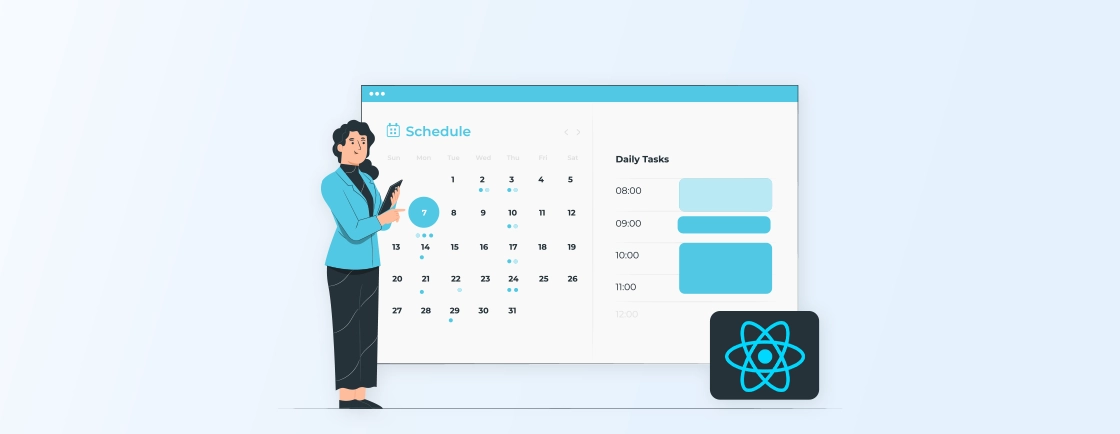Quick Summary
React JS is a leading JavaScript library for building dynamic, scalable web applications. Its core strength lies in a component-based architecture that promotes code reusability for better development and maintenance. Plus there’s the performance boost of a virtual DOM and a rich ecosystem of tools. That means fast, SEO-friendly, and highly interactive user interfaces. This makes it a top choice for developers and businesses aiming for efficiency and a superior user experience.
Table of Contents
When building a complex web application, developers need a framework that strikes a balance between performance and maintainability. Like, React JS. It’s become the definitive choice for building dynamic, enterprise-grade user interfaces.
Its component-based architecture lets developers create reusable code, improving efficiency and streamlining team collaboration. For those prioritizing scalable, search-friendly web apps, React offers a structured solution.
In this blog, we answer the question, “Why use React JS for web development?” by examining both the core technical and business advantages. By the end, you will have the information needed to determine if React JS is a suitable fit for your project. Let’s begin.
Why Use React JS for Web Development?
React’s dominance is not without reason. Using React JS for web development offers a suite of concrete advantages that address common development challenges and deliver tangible business value. Let’s cover them one by one.
Easy to Learn
Unlike more complex frameworks, React has a gentle learning curve. Its core concepts are built on fundamental JavaScript, allowing developers to become productive quickly. This accessibility reduces onboarding time for new team members and lowers the barrier to entry for building modern web applications.
Faster Development
React’s efficiency translates directly into accelerated project timelines. Its component-based structure and reusable elements mean developers write less code to achieve more. This streamlined process reduces development cycles, allowing teams to prototype, iterate, and launch features with remarkable speed.
Component-based Architecture
Imagine building with LEGO blocks. React breaks down complex user interfaces into independent, self-contained components. Each manages its own logic and design, making applications easier to build, test, and debug. This modular approach brings structure and scalability to even the largest projects.
Efficient Code Reusability
Build once, use everywhere. React’s components are designed for maximum reusability. A component created for one part of an application can be effortlessly dropped into another, ensuring consistency in design and function while eliminating redundant coding efforts.
Virtual DOM for Peak Performance
React creates a lightweight “virtual” representation of the DOM in memory. When data changes, React first updates this virtual copy, then intelligently updates only the specific parts of the real browser DOM. This minimizes slow, direct manipulations, resulting in a significantly faster and smoother user experience.
Rich Tool Ecosystem
React is supported by a mature suite of developer tools. Browser extensions like React DevTools allow for deep inspection of component hierarchies and state, streamlining debugging. This rich ecosystem provides powerful utilities that enhance the entire development lifecycle.
Search-friendliness
Unlike older JavaScript frameworks, React can be rendered on the server. This means search engines can easily crawl and index the content of your application, just like a traditional website. This server-side rendering capability is crucial for SEO, ensuring your web app is discoverable by users.
Efficient Data Binding
React employs a one-way data flow, meaning data is passed down the component tree in a single direction. This creates a more predictable and easier-to-debug application logic, as it’s always clear where data originates and how it propagates through your app.
Swift Rendering
React’s reconciliation algorithm is powered by the Virtual DOM. It’s exceptionally efficient at determining what needs to change in the UI. By batching updates and minimizing direct DOM manipulation, it ensures that even data-intensive applications remain responsive and smooth.
These are just a few benefits of using React JS for web development. And if you want to get the best of these benefits, you should opt for dedicated ReactJS development services.
But when will it be suitable to use React JS?
When to Use React JS?
React JS is a powerful tool, but its value is maximized in specific scenarios. It is the ideal choice when your project demands:
You Need a Highly-interactive User Interface
If your application requires dynamic content that updates without page reloads (e.g., dashboards, social feeds, live chat, data visualizations), React’s component-based model and efficient rendering are ideal.
Your Application is Complex and Will Scale
React’s component architecture forces you to build a modular, well-structured codebase. This makes large applications easier to manage, debug, and extend over time as your team and feature set grow.
Team Collaboration and Speed are Priorities
Reusable components allow multiple developers to work on different parts of the application simultaneously without conflict. This parallel development significantly accelerates time-to-market.
You Require a Native Mobile Presence
Using React Native, you can leverage your team’s React knowledge to build true native iOS and Android apps, sharing logic and development practices across web and mobile platforms.
Search-friendliness Matters
Unlike simpler JavaScript apps, React can be rendered on the server (Next.js, Gatsby). That provides crawlers with fully rendered HTML to improve search ranking.
Use React for building scalable, complex, and dynamic single-page applications (SPAs). It’s an excellent framework for where user experience and performance are critical.
For simpler, more content-focused websites (such as blogs or static brochures), a lighter solution may be more efficient. Speaking of when not to use React JS, let’s cover the scenarios.
When NOT to Use React JS?
While powerful, React introduces complexity that can be overkill for certain projects. Choosing the wrong tool can result in unnecessary overhead, longer development times, and a more difficult-to-maintain codebase.
Your Project is a Simple, Static Website
For basic marketing sites, blogs, or portfolios with minimal interactivity, React is unnecessary. Plain HTML, CSS, and a little JavaScript are simpler, faster to build, and more performant.
Your Team has Tight Deadlines and No React Experience
If your team specializes in another technology like Vue or Angular, the learning curve and setup time for React could delay your project. Use the tools your team already knows best.
Website Performance is an Absolute Top Priority
While React is fast, the library itself must be downloaded and executed by the browser. For the absolute smallest possible payload and fastest Time to Interactive (TTI), a vanilla JavaScript solution or a lighter framework might be better.
Your Application’s Primary Function is Not a Complex UI
If the project is form-heavy, server-rendered, and doesn’t require a dynamic single-page app (SPA) structure, a traditional multi-page application or a simpler solution might be more straightforward.
You Cannot Commit to Long-term Maintenance
React evolves quickly. Using it means committing to ongoing updates for its ecosystem (libraries, tools) and itself. For a small, one-time project, this maintenance burden may not be worthwhile.
Do not use React for simple, content-driven sites where its advanced features would be wasted. The likes of WordPress and Webflow would be better for that.
You can explore a detailed comparison of ReactJS, Angular, and VueJS to see how each framework stacks up against the others.
Best Practices for Using React JS for Web Development
Now, let’s say you have chosen React for your website or web app. How do you ensure the best results? Well, there are a few best practices involved.
Write Small, Reusable Components
Break your UI into small, single-responsibility components. This makes them easier to test, debug, and reuse across your project and others.
Use Functional Components and Hooks
Prefer modern functional components over class components. Utilize built-in Hooks like useState for state and useEffect for side effects for clearer and more concise logic.
Lift State Up When Necessary
Manage shared state in a common parent component and pass it down via props. This creates a single source of truth and prevents the state from getting out of sync.
Use a Key Prop for Lists
Always provide a unique and stable key prop when rendering lists of elements. This helps React efficiently identify which items have changed, improving rendering performance.
Keep State Immutable
Avoid directly mutating state objects or arrays. Instead, create copies using methods like the spread operator (…) to ensure reliable state updates and prevent subtle bugs.
Implement Controlled Components for Forms
Tie form inputs directly to React state. This makes forms predictable and gives you full control over their values and validation.
Use a Linter (ESLint)
Employ a linter like ESLint with React-specific rules. It will automatically enforce code style consistency and catch common errors as you write code.
Structure Your Project Logically
Organize your files and folders by feature or route, not by type. Grouping related components, hooks, and styles together makes features easier to locate and manage.
If you need help with ensuring the best results for your ReactJS web app, follow these practices to the tee.
Case Study on ReactJS for Web Development
Initially, Facebook was built on PHP, which aided in creating dynamic content and managing data effectively. But soon as Facebook started scaling up, they faced some challenges. They needed to build and maintain a complex, data-rich UI. Plus, the platform itself had to handle millions of simultaneous updates in real-time without performance or UX compromises.
So Facebook created ReactJS for scaling its platform and then later open-sourced it. Now, React is the foundational layer of Facebook’s web interface. That includes the core news feed and advertising platform.
As for the benefits, Facebook got performance at scale, developer velocity and maintainability, and reliability & scalability. That’s why experts consider ReactJS as one of the best options for building complex, high-performance applications.
Let’s Conclude
The decision to adopt a technology stack is a strategic one. It impacts not just development speed but also long-term maintainability and scalability. React JS stands out by addressing these core business concerns through its component-based architecture and efficient rendering.
It provides a structured yet flexible foundation for building dynamic, high-performance UIs that can evolve with your project’s needs. While no tool is a universal solution, React JS is a compelling choice for those aiming to build robust, competitive web applications.So, want help with building the best React-based web application? Then hire ReactJS developers with us today!
FAQs on Using ReactJS for Web Development
Is React a framework or a library?
React is a JavaScript library focused specifically on building user interfaces. It handles the application’s view layer. So you can combine it with other libraries for routing or state management, unlike a full-opinionated framework.
Do I need to learn JavaScript first for ReactJS?
Yes, a solid understanding of modern JavaScript (ES6+) is essential before learning React. Key concepts include functions, objects, arrays, and especially arrow functions, destructuring, and modules.
Is React suitable for large-scale applications?
Absolutely. React’s component-based architecture promotes reusability and separation of concerns, making it highly scalable. Its stability and extensive ecosystem are why many large enterprises use it for complex applications.
Can React websites be SEO-friendly?
Yes. While traditional client-side React can pose challenges to SEO, you can utilize frameworks like Next.js for server-side rendering (SSR) or static site generation (SSG). It provides fully rendered HTML to search engines, solving this common concern.
Is React good for startups?
Yes, React is excellent for startups. Its component-based architecture enables small teams to build and iterate on products rapidly. The vast ecosystem of reusable libraries reduces development time and cost.
And, React’s scalability ensures the application can grow seamlessly with the business, preventing costly early re-writes.
Is ReactJS cost-effective for web development?
React is highly cost-effective. Its core principle of reusability means developers write less code, accelerating development and simplifying maintenance.
Furthermore, its strong community support provides a wealth of free, high-quality tools and solutions. That significantly reduces the long-term development expenses and time-to-market.
Build Smarter with React JS
Whether you’re building a dynamic startup app or upgrading an enterprise platform, React can be the perfect choice. Dive deeper, make informed decisions, and turn your ideas into interactive reality by exploring React.JS for Web Development today. Book your session now.





